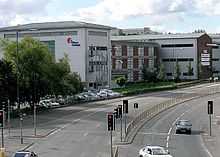Education in Bristol
Bristol is the largest city in South West England, and as such is a centre for culture, research and higher education in the region. The city is home to a prestigious "red brick university" (University of Bristol) and a high ranking "new university" (University of the West of England). The city is also noted for its investment in the sciences and engineering, particularly its ties to the aerospace industry.
Compulsory education
There are 105 state-funded Primary, Infant and Junior schools in Bristol. Of these, 33 are academies.
Of the 21 state-funded Secondary Schools in Bristol, most are now academies. Out of the four remaining schools one is a community school, one is a foundation school and the remaining two are voluntary aided schools.
A reform school was set up in 1854 by Mary Carpenter, with the financial help of the poet Lord Byron's widow, at Bristol's Red Lodge.
Further education
Sixth forms
Bristol has three main sixth forms, they are St. Brendan's Sixth Form College, North Bristol Post 16 Centre and Redcliffe Sixth Form Centre. St. Brendan's Campus is located in brislington just off the main route through; Redcliffe Sixth Form is, however, located closer to the centre of Bristol, and is to the west of Bristol Temple Meads train station and close to St Mary Redcliffe Church to the north.
Colleges

Bristol has two main colleges, they are City of Bristol College located on St George's Road, near College Green with many smaller sites across the city; and South Gloucestershire and Stroud College, which has a site at Filton in South Gloucestershire.
Higher education
Bristol has three universities, the University of Bristol, The University of Law and University of the West of England (UWE).
Bristol University, a member of the Russell Group, has 15,000 students, many who come from independent schools and middle-upper-class homes. Its particular strengths lie in Mathematics, Medicine, Engineering, Psychology, Economics, Biology, Chemistry, Management, Politics and Law. The University usually ranks in the top ten of British universities in newspaper league tables and was ranked 49th in the world in 2006, rising to 37th in the world in 2008 and again to 30th in 2013.[1]
The post-1992 UWE, previously known as Bristol Polytechnic, has around 35,000 students and 3,000 academic staff, UWE is the larger of the two universities in the city. 86% of students at UWE are from state schools.
The University of Law has a campus in the city. It is the largest provider of vocational legal training in Europe.[2]
In September 2008, the Bristol Institute of Modern Music opened as an offshoot of the Brighton Institute of Modern Music. BA (Hons) courses awarded by the institute are validated by the University of Sussex.
Science
In 2005, the Chancellor of the Exchequer recognised Bristol's ties to science and technology by naming it one of three "science cities", and promising funding for further development of science in the city, with a £300 million "Science Park" planned at Emerson's Green. As well as research at the two universities and Southmead Hospital, science education is important in the city, with At-Bristol, Bristol Zoo and Bristol Festival of Nature being prominent educational organisations.
The city has a history of scientific achievement, including Sir Humphry Davy, the 19th century scientist who worked in Hotwells and discovered laughing gas. Bishopston has given the world two Nobel Prize winning physicists: Paul Dirac for crucial contributions to quantum mechanics in 1933, and Cecil Frank Powell, for a photographic method of studying nuclear processes and associated discoveries in 1950. The city was birthplace of Colin Pillinger, planetary scientist behind the Beagle 2 Mars lander project, and is home to Adam Hart-Davis, presenter of various science related television programmes, and the psychologists Susan Blackmore, Richard Gregory, and Derren Brown.
Initiatives such as the Flying Start Challenge help encourage secondary school pupils around the Southwest to take an interest in Science and Engineering. Links with major Aerospace companies promote technical disciplines and advance student’s understanding of practical design.
References
- ↑ http://www.topuniversities.com/university-rankings/world-university-rankings/2013 "QS World University Rankings 2013", QS Quacquarelli Symonds
- ↑ "The College of Law". International Bar Association. Retrieved 20 January 2013.
| ||||||||||||||||||||||||||||||||||||||||||